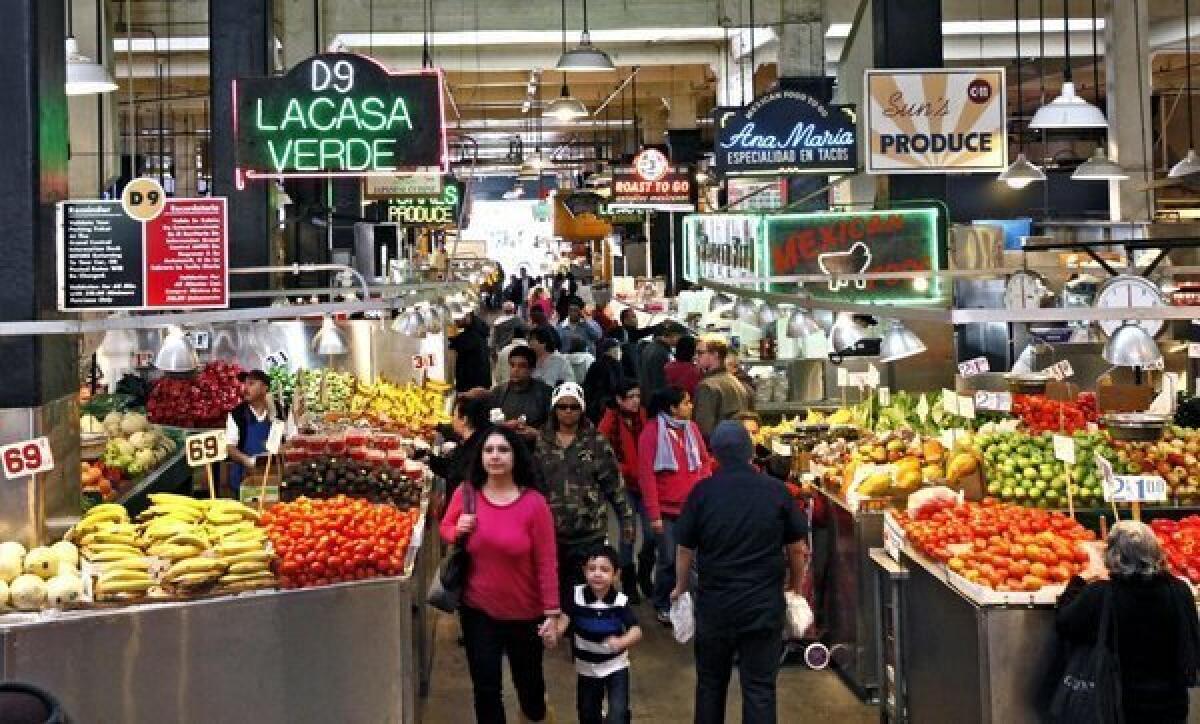Will Grand Central Market still be the ‘people’s market’?

- Share via
The Grand Central Market – downtown’s historic hub of international food, life and language – is headed for change, and not necessarily the good kind.
In an attempt to adjust to the times, or more precisely, downtown’s demographics, owner Adele Yellin, president of the development company started by her late husband Ira Yellin, is washing away the dust, painting over the wear and retooling the mix of offerings at the market.
But is that progress? Or, as some fear, will it take away the character from one of Los Angeles’ most historic gathering places.
In a cringe-worthy description of the market’s future, consultant Joseph Shuldiner, founder of the Institute of Domestic Technology and Altadena Farmers Market, said it will be transformed into a “community market version of a hotel lobby,” or “downtown’s living room.”
As The Times wrote last week, the face-lift is in response to a change in demographics. The population in the Central City has gone from more than 18,000 in 1998 to nearly 50,000 today, according to the Los Angeles Downtown Business Improvement District.
So are those new residents clamoring for a different kind of market? Or do they like it the way it is? Is the market’s owner upgrading in response to customer demand, or aiming for a new clientele? I’m betting on the latter.
Diving down into the numbers, the idea behind the proposed gentrification is clear.
Proportionally, downtown residents are more educated and wealthier than they were 10 years ago. In 2000, about 18% of downtown residents had a four-year college degree or higher. Now it’s above 27%, a 55% increase. The number of residents who make more than $125,000 a year has more than doubled since 2000, and the number making between $60,000 and $125,000 has increased by two-thirds. There are proportionally more whites and Asians and fewer blacks and Latinos than in 2000.
Did anyone consider that maybe part of the draw of downtown is this international bazaar?
Shuldiner said the plan is to add a wine and cheese area and create a central space for kitchen classes, tastings, studio shoots and private dinners.
“My fantasy is a pocket café or sushi bar under the stairs,” he told The Times.
This sounds like one of the biggest deviations from the market’s working-class roots in its nearly 100-year history. When Homer Laughlin opened the market in 1917, he said “we are trying to build up an institution.”
Indeed, Laughlin accomplished that goal. The marketplace became an institution for inexpensive, international food, where families from the surrounding blue-collar neighborhoods could shop and see their neighbors downtown.
During World War II, it was one of a few places in Los Angeles residents could receive their rations of coffee and meat.
It was where politicians went to meet the working man. In 1958, U.S. Sen. William F. Knowland, a Republican, walked the market, shaking hands and exchanging smiles during his run for governor against Pat Brown.
A gubernatorial candidate bellying up to the wine-and-cheese bar or pausing to converse with an office worker sipping a latte will be courting a very different kind of voter.
Putting a new coat of paint on the walls and a nice sheen to the floors is one thing, but a major upgrading of the market would likely lead to higher rents that could price out many of the current vendors—and their customers.
When Ira Yellin bought the market in the 1980s, he assured the public that the essence of what a previous owner had called the “people’s market” would remain unchanged.
“Whatever the changes, it will not become Westside cute,” he told The Times in 1985. “I want it to remain an authentic old food hall.”
If only Adele Yellin shared that vision.
ALSO:
Photo gallery: The Rose Parade through the years
2012 endings: Patt Morrison on what we won’t miss at all
More to Read
A cure for the common opinion
Get thought-provoking perspectives with our weekly newsletter.
You may occasionally receive promotional content from the Los Angeles Times.







